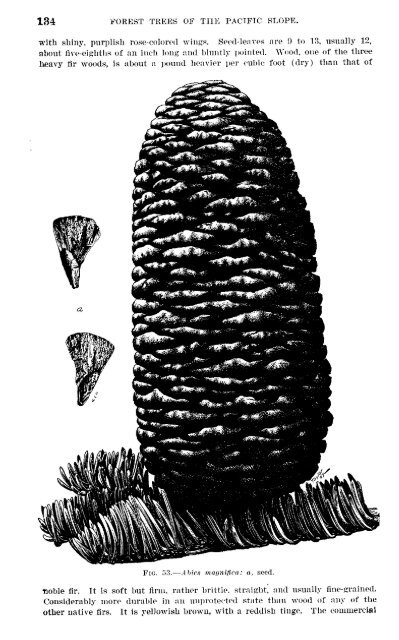De I. VNER VEW D Forest Trees of the Pacific Slope
De I. VNER VEW D Forest Trees of the Pacific Slope
De I. VNER VEW D Forest Trees of the Pacific Slope
Create successful ePaper yourself
Turn your PDF publications into a flip-book with our unique Google optimized e-Paper software.
FOREST TREES OF THE PACIFIC SLOPE. 65<br />
Reported from San Jacinto Mountains. Limited area on Mount Shasta at 4,000 to 5,600<br />
feet, between Pan<strong>the</strong>r and Mud creeks; eastward to Fall River. West slopes <strong>of</strong> nor<strong>the</strong>rn<br />
Sierras, at 1,500 to 3,000 feet-oceasionally to 4,000 feet, and southward to Yosemite<br />
National Park (?). <strong>Forest</strong> Hill (between forks <strong>of</strong> American River), at 2,500 feet elevation;<br />
aorth slope <strong>of</strong> Merced River (T. 3 S., R. 18-19 E.) in Sierra National <strong>Forest</strong><br />
(north) ; Lake Tahoe National <strong>Forest</strong>, only near Lynchburg, at 4,000 feet, and en ridge<br />
above Horse Shoe Bar (T. 13 N., It. 12 E.)<br />
OCCURRENCE.<br />
Usually on dry, exposed, steep sou<strong>the</strong>astern slopes, but <strong>of</strong>ten in deep gulches and protected<br />
ravines. On poor, dry, rocky, or gravelly and sandy soils. Next to digger<br />
pine it is <strong>the</strong> least fastidious <strong>of</strong> its kind regarding soil moisture. Frequently forms<br />
extensive pure forests, especially in Oregon; in foothills, it grows mainly in groups<br />
or singly, while in San Bernardino Mountains it is sparingly scattered in western<br />
yellow pine forests, with bigeone spruce, sugar pine, white fir, incense cedar, Coulter<br />
pine, and oaks.<br />
CLIMATIC CONDITloNs.-Endures seasonal temperature <strong>of</strong> from about zero to 950 F.,<br />
with occasional heavy snows and an annual rainfall up to 45 inches.<br />
TOLERANcE.-Next to digger pine, <strong>the</strong> least tolerant <strong>of</strong> <strong>Pacific</strong> coast pines.<br />
RsPRODUCTION.-Abundant annual seeder, bearing cones at very early age. Seed with<br />
high rate <strong>of</strong> germination and with very persistent vitality in cones, no matter how old<br />
<strong>the</strong> cones are. Old trees <strong>of</strong>ten bear over 3.5 pounds <strong>of</strong> seed. Few cones open except<br />
by <strong>the</strong> aid <strong>of</strong> fire, which is nearly always followed by abundant reproduction. Seed germinates<br />
in <strong>the</strong> most barren soils, and seedlings are hardy from <strong>the</strong> start.<br />
Pricklecone Pine; Bishop's Pine.<br />
Pinus muricata Don.<br />
DISTINGUISHIING CHARACTERISTICS.<br />
Pricklecone or bishop's pine is a little-known species which, on account <strong>of</strong><br />
Its endurance <strong>of</strong> conditions most unfavorable to <strong>the</strong> growth <strong>of</strong> o<strong>the</strong>r pines,<br />
deserves <strong>the</strong> forester's careful attention. Ordinarily it is from 30 to 60 feet<br />
high and from 12 to 20 inches in diameter; trees from 75 to 80 feet high<br />
and from 24 to 36 inches thick occur rarely. Young trees in an open or scattered<br />
stand have dense, pyramidal crowns and short, clear trunks. Older trees<br />
under such conditions bear a dense crown rounded at <strong>the</strong> top, with stout<br />
branches still extending low to <strong>the</strong> ground. In dense stands, in which it frequently<br />
occurs, <strong>the</strong> crown is much <strong>the</strong> same, but shorter, and <strong>the</strong> trunk is<br />
cleaner. The bark, early broken even on young trees, is deeply furrowed and<br />
rough, with dull purple-brown scales. The deep yellow-green foliage is conspicuously<br />
dense on <strong>the</strong> extremities <strong>of</strong> <strong>the</strong> numerous branches. The stiff leaves<br />
(fig. 24), 2 in a bundle, are from 3j to 5J inches long; usually 3A or 4 inches.<br />
Leaves <strong>of</strong> a season's growth fall from <strong>the</strong> branches during <strong>the</strong> second aind third<br />
summers. The cones (fig. 25), specially characterized by <strong>the</strong>ir indefinite persistence,<br />
are mature inAugust <strong>of</strong> <strong>the</strong> second season,when <strong>the</strong>ir prickly scales are<br />
shiny and a rich russet-brown. Many <strong>of</strong> <strong>the</strong>m open and shed <strong>the</strong>ir seed in September<br />
and October, while some <strong>of</strong> <strong>the</strong>m remain closed for a number <strong>of</strong> years.<br />
A singular fact concerning <strong>the</strong> persistent cones is that <strong>the</strong>y are rarely or never<br />
embedded in <strong>the</strong> stems <strong>of</strong> <strong>the</strong> trees, as in <strong>the</strong> case <strong>of</strong> o<strong>the</strong>r pines with persistent<br />
cones. The stems <strong>of</strong> <strong>the</strong> cones are broken and slowly drawn or forced from <strong>the</strong><br />
wood by each year's growth pushing against <strong>the</strong> base <strong>of</strong> <strong>the</strong> cone, which is<br />
sometimes lightly held by <strong>the</strong> living bark. The seeds (fig. 25, a) are blackish<br />
or very dark brown, with a roughish surface. Seed-leaves, usually 5, but <strong>of</strong>ten<br />
4. Wood, light yellowish-brown, ra<strong>the</strong>r heavy and hard, moderately coarsegrained;<br />
<strong>of</strong> o10 commercial use.<br />
LoNGEvITY.-Little is known concerning <strong>the</strong> longevity <strong>of</strong> this pine, which<br />
appears to grow rapidly in diameter for <strong>the</strong> first 40 or 50 years. <strong>Trees</strong> from

















